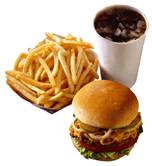
MONDAY, Jan. 25 (HealthDay News) — When nutritional information is available on fast-food restaurant menus, parents are more apt to pick lower-calorie foods for their kids, new research finds.
Often spurred on by legislation, many U.S. restaurant chains are now posting nutrition information about their menu items. But whether this information would translate to healthier eating was unclear.
The new study, conducted with McDonald’s menus, suggests that it does.
“When parents are provided with calorie information they chose about 100 calories less [per meal] for their 3- to 6-year-old child compared to parents who didn’t have that information,” said lead researcher Dr. Pooja Tandon, a graduate fellow in the department of general pediatrics at the University of Washington in Seattle.
“One hundred calories over time is actually a significant amount in terms of weight gain, given the rates of fast food consumption and childhood obesity in our country,” she added.
The report is published in the Jan. 25 online issue of Pediatrics.
For the study, Tandon’s team surveyed 99 parents of 3-to 6-year-olds about the foods they selected for their children at fast food restaurants.
The parents were given pictures of McDonald’s menu choices and asked which items they would pick for themselves and their children. Half of the menus had calorie information for each item and half did not.
Choices included sandwiches, salads, dressings, side items, beverages, desserts and children’s meals.
The team found that parents given menus with calorie information picked items with an average of 102 less calories for their children than did the parents whose menus didn’t have the calorie data.
However, there was no difference between the two groups in the calories of the items parents selected for themselves.
“We know that fast food consumption has been rising. We know that childhood obesity rates are alarmingly high,” Tandon said.
“These results make me optimistic that if parents are provided nutrition information at the point they are purchasing fast food for their children they actually make lower calorie, healthier choices for their families,” she said.
Tandon also hopes that restaurants will change their menus and offer more lower-calorie, healthier meals.
Samantha Heller, a registered dietitian, clinical nutritionist and exercise physiologist, said that “posting calories on menus is a good idea and registered dietitians like me are hoping it will help people make healthier choices when they eat out.”
Consumers also need to consider other food values such as salt, saturated fat and cholesterol, Heller said.
“Ordering healthier and lower-calorie foods for children and adults alike is certainly a goal to shoot for,” she said. “Obviously the epidemic of childhood obesity is of great concern, and we need to take action to ensure the health and well-being of our children.”
Heller said it was “unfortunate” that parents did not order lower-calorie foods for themselves.
“Parents are role models for their children. Not only do they need to stay healthy themselves, they need to set an example of engaging in healthy eating and lifestyle behaviors for their children,” she said.
Research presented in October at the Obesity Society annual meeting in Washington, D.C., mirror the findings of Tandon’s group. In that study, researchers surveyed more than 10,000 customers at 275 fast food restaurants in New York City. They found that those who saw or used the posted calorie information selected items totaling 106 fewer calories, compared with those who did not see or did not use the information.
More information
For more information on healthy eating, visit the U.S. Department of Agriculture.

